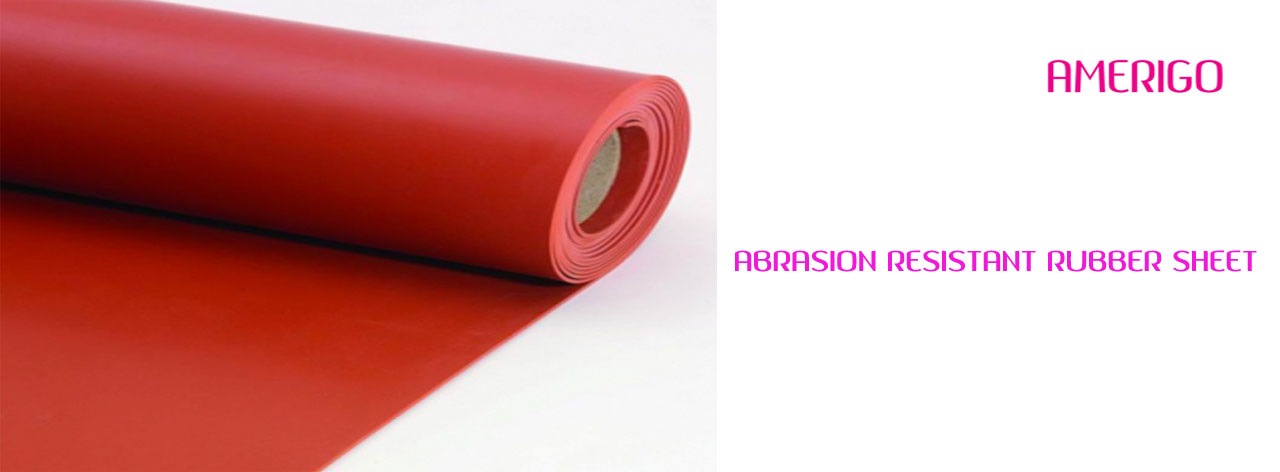ABRASION RESISTANT RUBBER SHEET MANUFACTURER
Amerigo manufactures ABRASION RESISTANT RUBBER SHEETS in India which are supplied to various industries as per it's applications.The ABRASION RESISTANT RUBBER SHEETS are ideally suited for a wide range of industrial applications. The abrasion-resistant rubber sheets are used in various industries where materials are exposed to friction, impact, or wear and tear. It provides cushioning and reduces wear from heavy foot traffic. It protects plows, harvesters, and grain handling equipment.

Features of Abrasion Resistant Rubber Sheets:
1. Industrial Applications :
Lining for Chutes, Hoppers, and Bins – Protects surfaces from material flow damage.
Conveyor Belt Covers – Increases the lifespan of conveyor belts in mining, cement, and aggregate industries.
Pulley Lagging – Enhances grip and reduces wear on conveyor pulleys.
2. Mining & Quarrying :
Wear Liners for Equipment – Extends the life of screens, crushers, and feeders.
Slurry Pump Linings – Resists abrasion from slurry and other harsh materials.
3. Construction & Infrastructure :
Bridge Bearing Pads – Provides durability in structural applications.
Road and Railway Buffers – Absorbs impact and reduces wear on critical parts.
4. Automotive & Transportation :
Mud Flaps & Wheel Guards – Protects vehicles from debris and wear.
Gaskets & Seals – Ensures longevity in harsh conditions.
5. Sports & Recreation :
Gym Flooring & Mats – Offers durability and impact resistance.
Protective Padding – Used in playgrounds, stadiums, and other high-impact areas.
Abrasion-resistant rubber sheets are designed to withstand wear, friction, and impact in industrial applications. Their technical parameters vary based on the type of rubber used (e.g., natural rubber, SBR, polyurethane, nitrile rubber, neoprene, etc.).
Key Properties of Abrasion Resistant Rubber Sheets:
1. Material Composition :
Natural Rubber (NR): High tensile strength and tear resistance.
Styrene-Butadiene Rubber (SBR): Improved wear resistance.
Nitrile Rubber (NBR): Oil and abrasion resistance.
Neoprene (CR): Moderate abrasion resistance with chemical stability.
Polyurethane (PU): Excellent abrasion and impact resistance.
2. Hardness (Shore A) :
Typically ranges from 40 to 80 Shore A, depending on application requirements.
Soft rubber (40-50 Shore A): Better impact absorption.
Hard rubber (60-80 Shore A): Greater resistance to wear.
3. Tensile Strength :
Ranges between 10 to 25 MPa, indicating the material's ability to withstand pulling forces.
4. Elongation at Break :
Typically 200% to 700%, depending on rubber type.
5. Density :
Usually 1.1 to 1.4 g/cm³, varying with composition.
6. Abrasion Resistance (DIN 53516):
80 to 300 mm³ loss (lower value = better resistance).
High-performance rubber: <100 mm³.
General rubber: 200-300 mm³.
7. Tear Strength :
20 to 50 kN/m, ensuring durability in tough environments.
8. Temperature Resistance :
Natural Rubber (NR, SBR): -40°C to +70°C.
Nitrile Rubber (NBR): -30°C to +100°C.
Neoprene (CR): -40°C to +120°C.
Polyurethane (PU): -30°C to +90°C.
9. Compression Set :
Typically 20% - 35% (indicating how much the material retains its shape after compression).
10. Chemical Resistance :
NR, SBR: Poor resistance to oils and chemicals.
NBR: Excellent resistance to oils and fuels.
Neoprene: Good resistance to chemicals and weather.
PU: High resistance to solvents and hydrocarbons.
11. Electrical Properties :
Insulating properties depend on rubber type.
Conductive or antistatic versions available for special applications.


